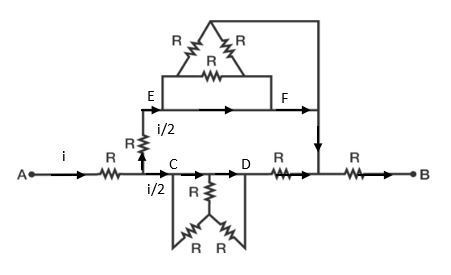Equivalent Resistance (1)
Find the equivalent resistance between and .
This section requires Javascript.
You are seeing this because something didn't load right. We suggest you, (a) try
refreshing the page, (b) enabling javascript if it is disabled on your browser and,
finally, (c)
loading the
non-javascript version of this page
. We're sorry about the hassle.
We know that the current prefers a low resistance path and if it is to travel between two points, then greater current will travel through the path will smaller resistance. If there is a zero resistance path between the two points, then all the current will flow through that path and the all the parallel paths will be considered short-circuited.
A similar situation occurs in this problem.
There exist a zero resistance path between points C , D and E , F . Hence the current will flow as follows.
This leaves us with the following equivalent circuit.
Now, applying series and parallel combinations, we get R e q = 2 R + 2 R = 2 5 R = 2 . 5 R .